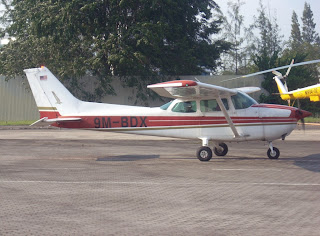A pilot never forgets how he became one and central to that memory is the aircraft that he trained with in his early flying years. Many who fly the skies around the world today began their flying on one particular make of aircraft, the Cessna. There's the Cessna 152 (called the C152) and there's the Cessna 172 Skyhawk (called the C172).The C152 is an ideal trainer since it is a side-by-side two-seater while the C172 is a four-seater and is therefore more popular with flyers.
The C152 was introduced in 1977 and production stopped in 1985. It is designed exactly like the C172 except that it is smaller.It also has an aerobatic version called the Aerobat for more advanced flying. Powered by a 110hp engine, it is a pleasant aircraft to fly. It takes off fairly quickly and the controls are so light that one feels that he is flying a toy. It is one of the aircraft types I flew as a student pilot and I certainly have fond memories of it.
 For most of my flying training and recreational flying in the subsequent years, it was the C172 Skyhawk that I dearly love as my personal steed. Not many call it the Skyhawk, probably because that name also belongs to a jet fighter-bomber used in many air forces. The C172 is a most forgiving aircraft which makes it suitable for new pilots especially when they make heavy or bouncy landings. Having its wings above the fuselage gives it more stability and the view of the ground below is as unrestricted as it can be. When dropping parajumpers off, the aircraft is flown with the right hand side door removed and still the aircraft is manageable with acceptable wind intrusion and noise.
For most of my flying training and recreational flying in the subsequent years, it was the C172 Skyhawk that I dearly love as my personal steed. Not many call it the Skyhawk, probably because that name also belongs to a jet fighter-bomber used in many air forces. The C172 is a most forgiving aircraft which makes it suitable for new pilots especially when they make heavy or bouncy landings. Having its wings above the fuselage gives it more stability and the view of the ground below is as unrestricted as it can be. When dropping parajumpers off, the aircraft is flown with the right hand side door removed and still the aircraft is manageable with acceptable wind intrusion and noise.
Introduced in 1955, the C172 is still in production and came with various powerplants of between 145hp to 180hp. There was also a retractable gear version called the Cutlass. Having flown several versions of the C172, I have got used to the high wing concept. Though the low-winged Pipers are more thrilling as they make me feel like I am flying a Spitfire or something, I still would choose the C172 for its practical design and simplicity of operation.
It is a sheer pleasure when about to begin a flight to just hear the strain of the starter motor as the propellor turns in sharp movements before the Lycoming engine sputters to life in a wisp of exhaust smoke and then settles down into a regular rhythm. Like the fuel that is being sucked in a constant flow from the wing tanks into the engine, the pilot's own adrenaline likewise flows!
